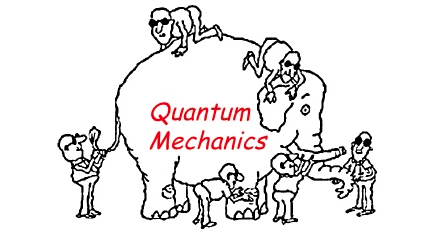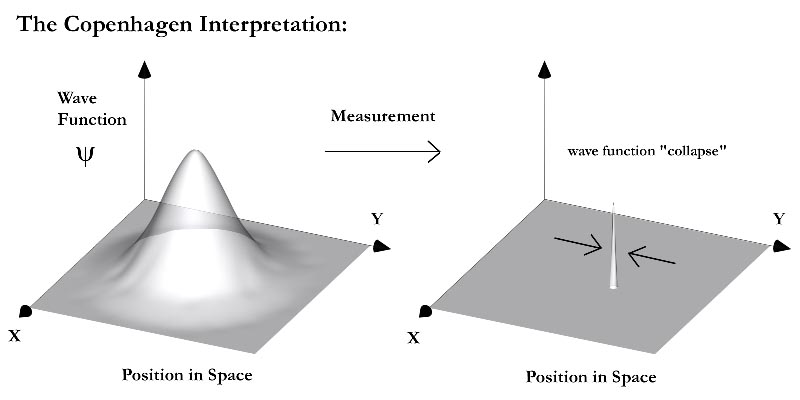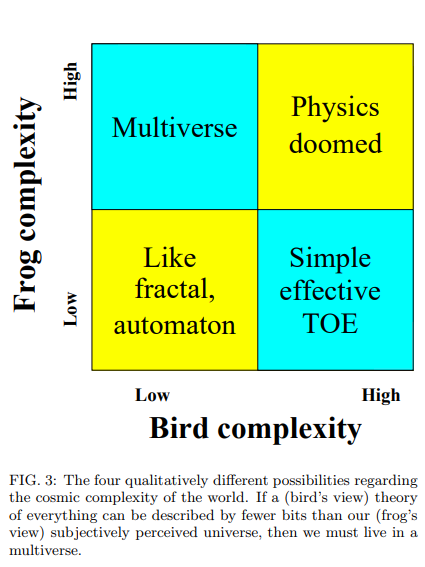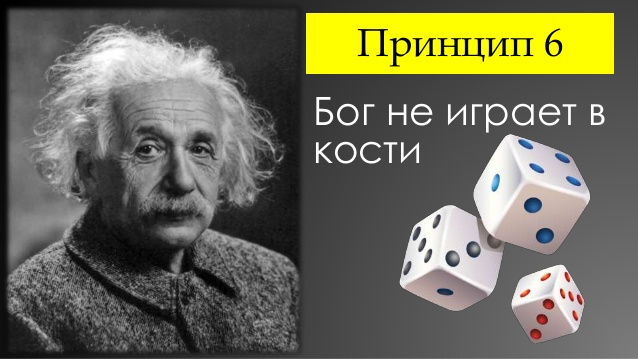Quantum mechanics: the end of the war of interpretations
Quantum mechanics is surrounded by a halo of mystery. Often, this halo arises from the fact that popular sources set out the material, not adhering to any specific interpretation, and sometimes try to squeeze modern facts into the Procrustean bed of the old Copenhagen interpretation.

A list of more than 17 interpretations can be found here . This whole long list arose from the fact that the formulas of quantum mechanics themselves guessed pretty quickly, but for a long time did not understand what they meant .
The Copenhagen interpretation has a special place: it is one of the first, if we take the chronology of occurrence. But, most importantly, it is the standard de facto popular explanations of quantum mechanics. This is where all the problems come from.
')
What are the parts of modern QM? (Relativistic) quantum mechanics is a kind of framework of formulas, filled with concrete information about which elementary particles are (the so-called menagerie ) plus the parameters of the Standard Model . These are 19 magic dimensionless numbers that the theory does not explain. But this is a topic for another conversation. Everything described above constitutes a part of pure formulas that is nice to the theorists. Now two additional, magical ingredients. Touched while one of them.

It is the result of measurement. Measurement is a process where almost weightless quantum-mechanical systems come into contact with classical measuring instruments, approximately the same as in the times of Niels Bohr:

Given that for a huge number of experiments, interpretation worked like a clock, none of its supporters could clearly explain what measurement is . As a rule, recursion occurs.Sepule Sepulation Sepulkary measurement / observation / observer ... which measures.
The presence of the observer, coupled with the fact that the collapse is partial (with a reasonable observer who can make an inference) even gave rise to the interpretation of Von Neumann-Wiener , which is called thedream of the mind creates monsters Collapse created by consciousness . I have nothing against Neumann and Wiener - this is just an illustration of how it was all bad. Even the talk about alternative interpretations became, if not taboo, it was considered useless chatter:

Recently, especially thanks to research in the field of quantum computing, measuring systems from huge instruments with arrows have decreased to tiny systems - sometimes the size of a few atoms. And the boundary between the quantum-mechanical system and the classical systems, which was blurred before, completely erased.
Why is this system of a couple of atoms a measuring device, but this one is not? Where are the “I Measuring Device” flags attached to groups of atoms? The Copenhagen interpretation has reached a philosophical impasse (which does not diminish its historical and pedagogical role).
However, physicists working in the field of quantum computing have not suffered from these problems for a long time, and this is why
I will not talk here about the Many Worlds Interpretation . About this theory, and so there is a lot of information (and often incorrect). Of the interesting facts, it should be noted that it was not Everett but Schrodinger who first came across her.
However, we will be interested in, but why didn’t the new theory win the minds right away (aside from being rejected because it was “stoned”)? Mainly because it contradicted the observed facts. Looking at the experiment with Schrödinger's cat, the theory predicted that we should see this:

But you will never see real objects in superposition. Therefore, for the time being, MWI was just a crazy hypothesis until it was revealed
Decoherence was detected at the tip of a pen in the early 70s. In the 80s there is an active study of this area. Now, without it, one cannot imagine modern quantum mechanics and, especially, quantum computers. In half of the articles about quantum computing, the word decoherence is in the title, and in almost every one is in the body of the article.
Decoherence shows that the interaction of a complex system (the observer) with a quantum (or other other system) causes diagonalization. That is, instead of two blurry silhouettes of a living and a dead cat, the system turns into two almost independent ones: a sad observer who sees a dead cat, and a joyful one who sees a live cat.
Unlike the collapse of the wave function, decoherence does not need the magic of “measurement” —this happens with any system that has many degrees of freedom (which is true for the brain and macroscopic observation devices). The decoherence process itself is physical, that is, due to the exchange of the observer and the object by photons (for example), it does not occur instantaneously, and the phenomenon itself does not spread faster than the speed of light.
The position of supporters of the Copenhagen interpretation is very weak. After all, now they have not one, but two whole agents, providing for what the collapse was previously responsible for. Obviously, this can not be. Catching at a straw, they try to declare decoherence an explanation of the collapse and even put it as a victory (they say, before the collapse was magic, and now it was explained)
The fatal problem of this approach is that decoherence is weaker than collapse — it explains why we do not see a hazy mixture of different states of cats, but it doesn’t say that only one state of the cat remains! That is, a supporter of this approach must either de facto become an adherent of the MWI, or still drag a saw into theory that will cut off the “unnecessary” branches.
The Born Rule is the last missing ingredient for MWI. Roughly speaking, this is a crutch that explains how the thickness of the branches affects reality. You are driving to work. In one of the branches of the multiverse, your brain pereklinilo, you stopped and rushed to rob a bank, and instead of work you were in jail. Fortunately, the intensity of this branch is very low. The rule explains that we hardly observe such thin branches. The rule is in other interpretations, in particular, in Copenhagen. And in February of this year, the crutch was removed .
As decoherence derived from the formalism of quantum mechanics supplanted collapse, so the Born rule was (finally !!!) derived in a purely mathematical way. The last nail in the coffin of the Copenhagen interpretation is clogged a month ago. The story is over. Time to sum up.
Let's compare the current state of the MWI and the Copenhagen interpretation and, as always, dispel the myths. So,
Copenhagen = Formulas + Wave Function Collapse + Born Rule
MWI = Formulas + ... and nothing more
Thus, MWI is an absolutely minimalist theory (it is sometimes even called the NULL interpretation ). It does not imply any additional principles, except the formalism, which is known for a long time. Many believe that Occam's razor cuts the MWI, because the MWI " postulates the existence of other, unobservable branches of reality ." MWI just does not postulate. The existence of these branches inevitably follows from the formulas of quantum mechanics, as the structure of the space inside a black hole follows from Einstein's formulas. On the contrary, in order to avoid additional branches, you just have to postulate the presence of a “saw”, which continuously cuts off these branches. Well, or langolier:

Suddenly, in MWI, quantum mechanics turns out to be deterministic, objective, and local — well, just a warm tube theory. Of course, it is only globally determined (if you look at the development of all branches) - this is called birds view, and from the point of view of the internal observer, “frogs view” - events in the universe are random (but statistically subject to the Born rule).

(again from the Max Tegmark article)
Some people believe that MWI is a desperate attempt to return determinism to science.

Spoiler: The old man was right!
No and no again. On physicsforums, I somehow inquired about the motivation of die-hard realists who fought a desperate war with Bell's theorem (at that time not all the loopholes in the experiments were closed). Bell's theorem forbids the existence of local realistic theories in the framework of quantum mechanics - however, this theorem does not apply to MWI. Accordingly, for those in love with realism, going under the flags of MWI would solve all the problems (as it seemed to me). But no - thunder and lightning struck me - the cost of recognizing a multiverse for realists was absolutely unacceptable , more unacceptable than even parting with their favorite realism. This leads to the conclusion:
MWI - you have to pay for everything just once. Take insanity in one thing - and everything else will become easier. Or all life spin in chimeras such as collapse , confusion, instantly changing the state of tangled particles, no matter how far they are , or wave-particle duality . By the way, the well-known Hawking was for MWI ( proof of Martin Gardner reports Hawking saying that MWI is “trivially true”).
Request to the public who read my previous article to participate in a short survey on the topic of consciousness and Qualia HERE in Google Forms
Thank!

A list of more than 17 interpretations can be found here . This whole long list arose from the fact that the formulas of quantum mechanics themselves guessed pretty quickly, but for a long time did not understand what they meant .
Ingredients of the Copenhagen Interpretation
The Copenhagen interpretation has a special place: it is one of the first, if we take the chronology of occurrence. But, most importantly, it is the standard de facto popular explanations of quantum mechanics. This is where all the problems come from.
')
What are the parts of modern QM? (Relativistic) quantum mechanics is a kind of framework of formulas, filled with concrete information about which elementary particles are (the so-called menagerie ) plus the parameters of the Standard Model . These are 19 magic dimensionless numbers that the theory does not explain. But this is a topic for another conversation. Everything described above constitutes a part of pure formulas that is nice to the theorists. Now two additional, magical ingredients. Touched while one of them.
Wave function collapse

It is the result of measurement. Measurement is a process where almost weightless quantum-mechanical systems come into contact with classical measuring instruments, approximately the same as in the times of Niels Bohr:

Given that for a huge number of experiments, interpretation worked like a clock, none of its supporters could clearly explain what measurement is . As a rule, recursion occurs.
The presence of the observer, coupled with the fact that the collapse is partial (with a reasonable observer who can make an inference) even gave rise to the interpretation of Von Neumann-Wiener , which is called the

Current situation
Recently, especially thanks to research in the field of quantum computing, measuring systems from huge instruments with arrows have decreased to tiny systems - sometimes the size of a few atoms. And the boundary between the quantum-mechanical system and the classical systems, which was blurred before, completely erased.
Why is this system of a couple of atoms a measuring device, but this one is not? Where are the “I Measuring Device” flags attached to groups of atoms? The Copenhagen interpretation has reached a philosophical impasse (which does not diminish its historical and pedagogical role).
However, physicists working in the field of quantum computing have not suffered from these problems for a long time, and this is why
New Hope
I will not talk here about the Many Worlds Interpretation . About this theory, and so there is a lot of information (and often incorrect). Of the interesting facts, it should be noted that it was not Everett but Schrodinger who first came across her.
However, we will be interested in, but why didn’t the new theory win the minds right away (aside from being rejected because it was “stoned”)? Mainly because it contradicted the observed facts. Looking at the experiment with Schrödinger's cat, the theory predicted that we should see this:

But you will never see real objects in superposition. Therefore, for the time being, MWI was just a crazy hypothesis until it was revealed
Quantum Decoherence
Decoherence was detected at the tip of a pen in the early 70s. In the 80s there is an active study of this area. Now, without it, one cannot imagine modern quantum mechanics and, especially, quantum computers. In half of the articles about quantum computing, the word decoherence is in the title, and in almost every one is in the body of the article.
Decoherence shows that the interaction of a complex system (the observer) with a quantum (or other other system) causes diagonalization. That is, instead of two blurry silhouettes of a living and a dead cat, the system turns into two almost independent ones: a sad observer who sees a dead cat, and a joyful one who sees a live cat.
Unlike the collapse of the wave function, decoherence does not need the magic of “measurement” —this happens with any system that has many degrees of freedom (which is true for the brain and macroscopic observation devices). The decoherence process itself is physical, that is, due to the exchange of the observer and the object by photons (for example), it does not occur instantaneously, and the phenomenon itself does not spread faster than the speed of light.
But what about the collapse of the wave function?
The position of supporters of the Copenhagen interpretation is very weak. After all, now they have not one, but two whole agents, providing for what the collapse was previously responsible for. Obviously, this can not be. Catching at a straw, they try to declare decoherence an explanation of the collapse and even put it as a victory (they say, before the collapse was magic, and now it was explained)
The fatal problem of this approach is that decoherence is weaker than collapse — it explains why we do not see a hazy mixture of different states of cats, but it doesn’t say that only one state of the cat remains! That is, a supporter of this approach must either de facto become an adherent of the MWI, or still drag a saw into theory that will cut off the “unnecessary” branches.
Born's rule
The Born Rule is the last missing ingredient for MWI. Roughly speaking, this is a crutch that explains how the thickness of the branches affects reality. You are driving to work. In one of the branches of the multiverse, your brain pereklinilo, you stopped and rushed to rob a bank, and instead of work you were in jail. Fortunately, the intensity of this branch is very low. The rule explains that we hardly observe such thin branches. The rule is in other interpretations, in particular, in Copenhagen. And in February of this year, the crutch was removed .
As decoherence derived from the formalism of quantum mechanics supplanted collapse, so the Born rule was (finally !!!) derived in a purely mathematical way. The last nail in the coffin of the Copenhagen interpretation is clogged a month ago. The story is over. Time to sum up.
Results
Let's compare the current state of the MWI and the Copenhagen interpretation and, as always, dispel the myths. So,
Copenhagen = Formulas + Wave Function Collapse + Born Rule
MWI = Formulas + ... and nothing more
Thus, MWI is an absolutely minimalist theory (it is sometimes even called the NULL interpretation ). It does not imply any additional principles, except the formalism, which is known for a long time. Many believe that Occam's razor cuts the MWI, because the MWI " postulates the existence of other, unobservable branches of reality ." MWI just does not postulate. The existence of these branches inevitably follows from the formulas of quantum mechanics, as the structure of the space inside a black hole follows from Einstein's formulas. On the contrary, in order to avoid additional branches, you just have to postulate the presence of a “saw”, which continuously cuts off these branches. Well, or langolier:

Suddenly, in MWI, quantum mechanics turns out to be deterministic, objective, and local — well, just a warm tube theory. Of course, it is only globally determined (if you look at the development of all branches) - this is called birds view, and from the point of view of the internal observer, “frogs view” - events in the universe are random (but statistically subject to the Born rule).

(again from the Max Tegmark article)
Some people believe that MWI is a desperate attempt to return determinism to science.

Spoiler: The old man was right!
No and no again. On physicsforums, I somehow inquired about the motivation of die-hard realists who fought a desperate war with Bell's theorem (at that time not all the loopholes in the experiments were closed). Bell's theorem forbids the existence of local realistic theories in the framework of quantum mechanics - however, this theorem does not apply to MWI. Accordingly, for those in love with realism, going under the flags of MWI would solve all the problems (as it seemed to me). But no - thunder and lightning struck me - the cost of recognizing a multiverse for realists was absolutely unacceptable , more unacceptable than even parting with their favorite realism. This leads to the conclusion:
MWI - you have to pay for everything just once. Take insanity in one thing - and everything else will become easier. Or all life spin in chimeras such as collapse , confusion, instantly changing the state of tangled particles, no matter how far they are , or wave-particle duality . By the way, the well-known Hawking was for MWI ( proof of Martin Gardner reports Hawking saying that MWI is “trivially true”).
PS
Request to the public who read my previous article to participate in a short survey on the topic of consciousness and Qualia HERE in Google Forms
Thank!
Source: https://habr.com/ru/post/444850/
All Articles